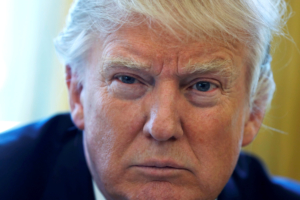
“It would be wonderful, a dream would be that no country would have nukes, but if countries are going to have nukes, we’re going to be at the top of the pack,” President Donald Trump said in an interview with Reuters correspondent Steve Holland on Feb. 23. The statement came as a part of a wider call for increased military strength in all sectors of the armed forces. An unequivocal policy of global nuclear domination by the United States was clearly spelled out: “We’re never going to fall behind any country even if it’s a friendly country, we’re never going to fall behind on nuclear power.” Press Secretary Sean Spicer went on to clarify and reinforce Trump’s statement that the U.S. intended to pursue a policy of nuclear proliferation that would place its “nuclear superiority” beyond question.
These comments came nearly a week after a successful missile test by North Korea. The president spoke of the missile test in ominous terms, and directed much of his criticism toward Kim Jong-Un directly. ”It’s very late. We’re very angry at what he’s done, and frankly this should have been taken care of during the Obama administration,” Trump told Reuters.
Militant nationalism in the age of Trump
One of the hallmarks of the Trump campaign, which has continued to find expression in his presidency, is an emphasis on U.S. military superiority. Both White House officials and the president himself have repeatedly declared a vast increase in military strength to be a top priority for the new administration.
The preferred foreign policy of the Trump administration has been one of deterring potential enemies through sheer force of arms, which is often condensed to “peace through strength.” This has been the policy of virtually every president since WWII, but is particularly associated with Ronald Reagan and the manic defense spending of the 1980s. According to the National Priorities Project, the U.S. spent 54 percent of its total budget in 2015 on defense, exceeding the military budgets of the next ten highest countries combined. In spite of this, senior Republicans have fallen in line with Trump’s call for a massive boost in U.S. military power, including the nuclear arsenal.
Nuclear non-proliferation group The Ploughshares Fund places the total number of nuclear warheads in the U.S. arsenal at 6,800, including 1,750 currently deployed on submarines, missiles and bombers according to the independent Arms Control Association. Russia is estimated to have roughly 7,000 warheads, and possesses the only other mass stockpile of nuclear weapons. According to the ACA the cost of maintaining current U.S. nuclear weapons systems for the next 30 years will reach over $1 trillion. Achieving “nuclear superiority” would require an additional investment of billions and a renewal of the process of warhead manufacture. It would also constitute a serious challenge to the START treaty, which seeks to limit the proliferation of nuclear weapons by the United States and Russia and was renewed under then-President Barack Obama.
A defining feature of Trump-era nationalism is its explicitly aggressive and militaristic character. Military expenditures are not justified by the need to “make the world safe for democracy” as Woodrow Wilson once claimed. Nor are such expenditures said to be necessary in order to make the U.S. “the arsenal of democracy” in the style of FDR. Instead, the proposed military buildup is justified by a need for U.S. military strength in a general sense, not directed against any particular enemy but against any and all potential enemies. This perspective promotes the idea that the U.S. will continue to play the dominant role in international affairs as a result of this overwhelming military force, and that this arrangement is beneficial for all involved.
Looking ahead
The Trump agenda is marked as much by xenophobic nationalism as by an overtly pro-capitalist foreign policy. Trump’s statement that he intends for the U.S. to be the “top of the pack” in the field of nuclear weapons is typical, if alarming. The notion of deterrence through strength is a popular one, and it has been a key element of both the Trump campaign and his emerging administrations policies.
The call for sweeping expansions of the armed forces and additions to the nuclear arsenal are a brazen attempt to reinforce U.S. hegemony by force of arms. In this way it is an extension of the previous administration’s policies. However, there is a particularly aggressive character to Trump-era nationalism that gives many pause.
Appearing on MSNBC via telephone in December 2016, Trump was asked about the possibility of sparking an arms race with other countries by ramping up the size of the military. He responded, “Let it be an arms race. We will outmatch them at every pass and outlast them all.”
In the face of such undisguised warmongering, leftists and progressives in the U.S. are faced with the tremendous challenge of organizing to counter it. We can achieve a great deal by taking to the streets in protests and direct actions, but we have an obligation to take that initiative further. By committing ourselves to educating and agitating the masses of U.S. workers who have been drawn into political consciousness by the unjust policies of the Trump administration, we can begin to build a truly working-class movement to counter imperialism here in the belly of the beast.





